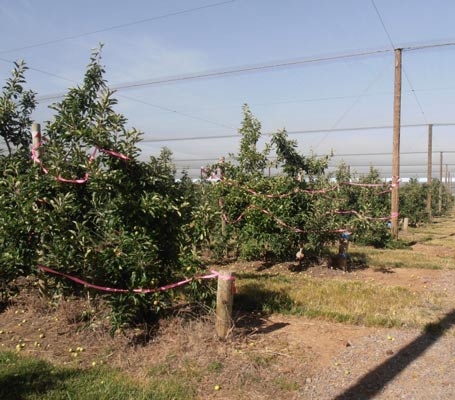Shade-netting (continued)
Environment
The environment beneath netting is most obviously characterised by lower radiation levels.
Recent measurements in a typical netted apple orchard in the Goulburn Valley showed that under a pale grey netting at the time of day when fruit are at greatest risk of sun damage (3:30 pm), total solar radiation was reduced by 16%, direct solar radiation by 23% and ultraviolet-B radiation by 36% while diffuse radiation was increased by 32% (Figure 3).
Various reports have found that day-time air temperatures under netting can decrease or increase compared to air temperature outside the netting.
When increases occur, they tend to be no more than 1C. Any increase in air temperature under nets is more than offset by reduction in fruit surface temperatures because the net decreases amounts of solar radiation available to heat the fruit.
A recent study by the Department of Economic Development, Jobs, Transport & Resources (formerly DEPI) in the Goulburn Valley found that netting was able to reduce median fruit surface temperatures by 1.5 to 2.0C but the difference was 4.0C for the hottest fruit in each orchard.
The mechanism for this effect was the capacity of netting to reduce the intensity of direct solar radiation on the fruit surface by interception and scattering of the sunlight.
Furthermore, the open sides of the netting structure allowed good air-flow through the netted area so that heat from the fruit surface could be easily transferred to the air and from the netted area to outside.
Reducing sunburn
Several reports support the claim that netting directly reduces sunburn.
In South-Eastern Queensland, hail-netting reduced sunburn of Granny Smith apples from 20% to 4% (Middleton & McWalters 1997).
Shade nets of 55% weave density decreased Fuji fruit sunburn but no differences were found between 15% weave density shade net and control treatments (Dussi et al. 2005).
Potential disadvantages
There can be potential disadvantages when nets are used.
Changes to the intensity and quality of light intercepted by plants may affect vegetative growth, yield and some aspects of fruit quality (e.g. colour). Several reports suggest that over-tree netting can impair colour development in red apple varieties (Blanke 2009; Dussi et al. 2005).
Netted orchards need to rapidly attain and maintain high yields and pack-outs to recoup the cost of netting and its support structures. Given the wide range of netting types and structures available, each with different levels of effectiveness against hail, pests and sunburn, growers are advised to seek technical information from their potential suppliers.
Evaporative cooling
When heatwaves have occurred in SE Australia during the past five years, over-head sprinklers used in a small number of orchards have commonly been observed to contribute to reduced heat damage to fruit.
(Continues next month)
See this article and photos, Tree Fruit March 2015




















